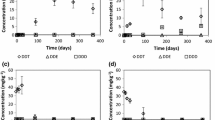Abstract
Bioremediation is an economically attractive option to remediate soil contaminated with DDT [1,1,1-trichloro-2,2-bis(p-chlorophenyl)ethane] and other organochlorine pesticides. However, lack of DDT bioavailability in soil presents one major obstacle to this technology particularly in soils that have been contaminated for long periods. In this work, sodium ion (Na+) was applied to a long-term DDT contaminated soil as Na+ is known to disperse clays, which would potentially release and/or expose physically protected DDT thereby enhancing DDT bioavailability. Sodium ion addition significantly increased dissolved organic carbon (DOC) levels, anaerobic bacterial numbers and the amount of DDT residues measured in soil solution. DDT transformation ranged from 95% (30—80 mg Na+ kg-1 soil) to 72% (no Na+ added) with the optimum level of DDT transformation occurring at 30 mg Na+ kg-1 soil. Higher Na+ levels repressed DDT transformation and this appeared to be related to lower DOC levels and flocculation of soils. The anaerobic incubation conditions employed (high water content) prevented DDE [1,1-dichloro-2,2-bis(p-chlorophenyl)ethylene] production and DDD [1,1-dichloro-2,2-bis(p-chlorophenyl)ethane] was the major breakdown product formed. Overall it appeared that Na+ has potential as a cheap and safe alternative to surfactants as a method for increasing DDT transformation in contaminated soil.
Similar content being viewed by others
References
Boul, H. L.: 1995, ‘DDT residues in the environment - A review with a New Zealand perspective’, N. Z. J. Agric. Res. 38, 257-277.
Boulding, J. R.: 1995, Practical Handbook of Soil, Vadose Zone and Ground-Water Contamination: Assessment, Prevention, and Remediation, Lewis Publishers, London, pp. 948.
Colborn, T. and Smolen, M. J.: 1996, ‘Epidemiological analysis of persistent organochlorine contaminants in cetaceans’, Rev. Environ. Contam. Toxicol. 146, 91-172.
Castro, T. F. and Yoshida, T.: 1971, ‘Degradation of organochlorine insecticides in flooded soils in the Philippines’, J. Agric. Food Chem. 19, 1168-1170.
Ding, J.Y. and Wu, S.C.: 1997, ‘Transport of organochlorine pesticides in soil columns enhanced by dissolved organic carbon’, Water Sci. Technol. 25, 139-145.
Fujimura, Y., Kuwatsuka, S. and Katayama, A.: 1996, ‘Bioavailability and biodegradation rate of DDT by Bacillus sp. B75 in the presence of dissolved humic substances’, Soil Sci. Plant Nutr. 42, 375-381.
Garrison, A.W., Nzengung, V. A., Ellington, J. J., William, J. J., Rennels, D. and Wolfe, N. L.: 2000, ‘Phytodegradation of p, p'-DDT and the enantiomers of o, p'-DDT’, Environ. Sci. Technol. 34, 1663-1670.
Hay, A. G. and Focht, D. D.: 1998, ‘Cometabolism of 1,1-dichloro-2,2-bis (4-chlorophenyl) ethylene by Pseudomonas acidorans M3GY grown on biphenyl’, Appl. Environ. Microbiol. 64, 2141- 2146.
Hay, A. G. and Focht, D. D.: 2000, ‘Transformation 1,1-dichloro-2, 2-(4-chlorophenyl) ethane (DDD) by Ralstonia eutropha strain A5’, FEMS Microbiol. Ecol. 31, 249-253.
Kantachote, D., Naidu, R., Singleton, I., McClure, N. and Harch, B. D.: 2001, ‘Resistance of microbial population in DDT-contaminated and uncontaminated soils’, Appl. Soil Ecol. 16, 85-90.
Kantachote, D.: 2001, ‘The use of microbial inoculants to enhance DDT degradation in contaminated soil’, Ph.D. Thesis, Department of Soil and Water, University of Adelaide, pp. 191.
Kaspar, H. F. and Tiedje, J. M.: 1994, ‘Anaerobic Bacteria and Process’, inWeaver et al. (eds), Methods of Soil Analysis. Part 2, Microbiological and Biochemical Properties, SSSA Book Series. No. 5, Wisconsin, pp. 223-243.
Kazman, Z., Shainberg, I. and Gal, M.: 1983, ‘Effect of low levels of exchangeable sodium and applied phosphogypsum on the infiltration rate of various soils’, Soil Sci. 135, 184-192.
Kucklick, J. R. and Baker, J. F.: 1998, ‘Organochlorines in Lake Superior's food web’, Environ. Sci. Technol. 32, 1192-1198.
Lal, R. and Saxena, D. M.: 1982, ‘Accumulation, metabolism, and effects of organochlorine insecticides on microorganisms’, Microbiol. Rev. 46, 95-127.
Megharaj, M., Boul, L. H. and Thiele, J. H.: 1999, ‘Persistence and toxicity of DDT and its metabolites toward native algal populations and enzymatic activities in soil’, Biol. Fert. Soils 29, 130-134.
Megharaj, M., Kantachote, D., Singleton, I. and Naidu R.: 2000, ‘Effects of long-term contamination of DDT on soil microflora with special reference to soil algae and algal metabolism of DDT’, Environ. Pollut. 109, 35-42.
Megharaj, M., Jovcic, A., Boul, H. L. and Thiele, J. H.: 1997, ‘Recalcitrance of 1,1-dichloro-2,2-bis (p-chlorophenyl) ethane (DDE) to cometabolic degradation by pure cultures of aerobic and anaerobic bacteria’, Arch. Environ. Contam. Toxicol. 33, 141-146.
Nadeau, L. J., Breen, M. F. and Sayler, G. S.: 1994, ‘Aerobic degradation of 1,1,1-trichloro-2,2-bis (4-Chlorophenyl) ethane (DDT) by Alcaligenes eutrophus A5’, Appl. Environ. Microbiol. 60, 51-55.
Nelson, P. N. and Oades, J. M.: 1998, ‘Organic Matter, Sodicity, and Soil Structure’, in M. E. Sumner and R. Naidu (eds), Sodic Soils: Distribution, Properties, Management, and Environmental Consequences, Oxford, pp. 51-75.
Parr, J. F. and Smith, S.: 1974, Degradation of DDT in an everglades muck as affected by lime, ferrous ion, and anaerobiosis’, Soil Sci. 118, 45-52.
Rayment, G. E. and Higginson, F. R.: 1992, Australian Laboratory Handbook of Soil and Water Chemicals Methods, Inkata Press, Sydney, pp. 330.
Rengasamy, P., Greene, R. S. B., Ford, G.W. and Mehanni, A. H.: 1984, ‘Identification of dispersive behaviour and the management of red-brown earths’, Aust. J. Soil Res. 22, 413-431.
White, R. E.: 1997, Principles and Practice of Soil Science: The Soil as a Natural Resource, 3rd ed., Blackwell Science Ltd., Carlton, pp. 348.
Wood, M.: 1995, Environmental Soil Biology, 2nd ed., Chapman & Hall, Tokyo, pp. 150.
You, G., Sayles, G. D., Kupferle, M. J., Kim, I. S. and Bishop, P. L.: 1996, ‘Anaerobic DDT biotransformation: Enhancement by application of surfactants and low oxidation reduction potential’, Chemosphere 32, 2269-2284.
Author information
Authors and Affiliations
Corresponding author
Rights and permissions
About this article
Cite this article
Kantachote, D., Singleton, I., Naidu, R. et al. Sodium Application Enhances DDT Transformation in a Long-Term Contaminated Soil. Water, Air, & Soil Pollution 154, 115–125 (2004). https://doi.org/10.1023/B:WATE.0000022934.70231.1a
Issue Date:
DOI: https://doi.org/10.1023/B:WATE.0000022934.70231.1a




